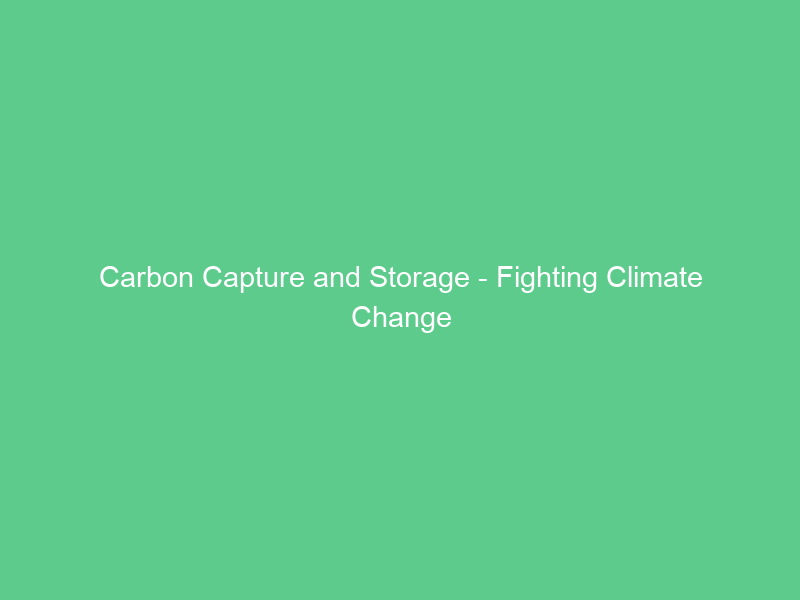Carbon Capture and Storage (CCS) is one strategy for mitigating greenhouse gas emissions from fossil fuel power plants and other industrial facilities. CCS utilizes technologies that capture CO2, transport it underground and store it permanently.
CO2 can be stored safely for millions of years by injecting it into saline aquifers or depleted oil and gas fields such as the North Sea’s “Endurance”, before being stored underground within rock formations similar to those that have housed oil and gas deposits for millions of years.
Capture
This technology captures greenhouse gas emissions from power plants and energy-intensive industries before they escape into the atmosphere, turning them into liquid form for underground storage. Unfortunately, however, its deployment remains only partially deployed today and must be expanded substantially in order to fulfill international commitments.
At present, 26 carbon capture and storage (CCS) projects exist worldwide. Some use pre-combustion carbon capture, where fuel is gasified (rather than burned) to form syngas containing both CO2 and hydrogen; then using physical solvents separates out only CO2. Finally it’s stored or transported away permanently for long-term geological storage.
Other CCS processes involve extracting CO2 from fossil fuel plants after they have been burned, thus mitigating some of their impacts. Although these technologies can reduce emissions intensive facilities’ environmental impacts, they cannot be used as an excuse to delay rapidly decreasing fossil fuel production. Furthermore, these solutions do not address local communities affected by those facilities, or harms they cause them – these issues would be better addressed through using cleaner production technologies and community-led solutions.
Transport
CCS must capture emissions from fossil fuel power plants and energy intensive industries before they reach the atmosphere; this can be accomplished using various techniques ranging from using trees to absorb CO2, to collecting it at coal and oil plants and storing it deep underground.
If the CO2 cannot be utilized on-site, it must be transported for permanent storage – this is where transport networks become key components to decarbonizing key industries and regions.
Current CO2 transportation projects are small-scale; to reduce carbon dioxide emissions, their networks need to expand and improve – this can be accomplished with targeted support for BECCS/DAC projects; their goal should be increasing capacity so as to meet net zero ambitions – this may require investing in infrastructure like CO2 pipelines.
Storage
Carbon capture and storage technology intercepts CO2 emissions from power stations and industrial facilities before they enter the atmosphere, transports it underground and permanently stores it there.
Technology is currently being developed to meet international climate change goals by preventing fossil-fuel emissions and storing them safely, such as using bioenergy with carbon capture and storage (BECCS), direct air capture or enhanced rock weathering processes.
CO2 can be collected via various means such as collection points or capture ships, then compressed into a liquid state for transport via pipeline or ship to its storage sites – usually depleted oil and gas reservoirs or coal beds that provide suitable conditions. Once at its destination, CO2 injection occurs within these geologic formations for permanent storage.
Structural Trapping uses rock layers and faults within and above a storage formation to prevent CO2 from migrating laterally or vertically; Saline formations also offer vast potential underground storage capacity around the world; other storage methods involve chemical reactions between CO2 and water or another substance to form solid minerals that then remain stored underground.
Utilization
Carbon dioxide emissions from fossil fuels are a key contributor to global warming. To mitigate its harmful impacts, capturing and storing CO2 underground permanently are also required.
There are two methods available to capture CO2, post-combustion capture at power plants using chemical solvents or oxyfuel capture in which fossil fuels are burned in pure oxygen to separate carbon dioxide from exhaust gasses. Both require significant energy input; research efforts are underway to develop less energy intensive methods of CO2 capture.
Once captured, CO2 is transported via pipeline or ship to its storage site for long-term storage in deep geological formations like used oil and natural gas reservoirs or saline formations for long-term storing.
CO2 can also be turned into useful products like cement or plastics; life cycle analysis shows that using CO2 has lower environmental impacts than storing it.

